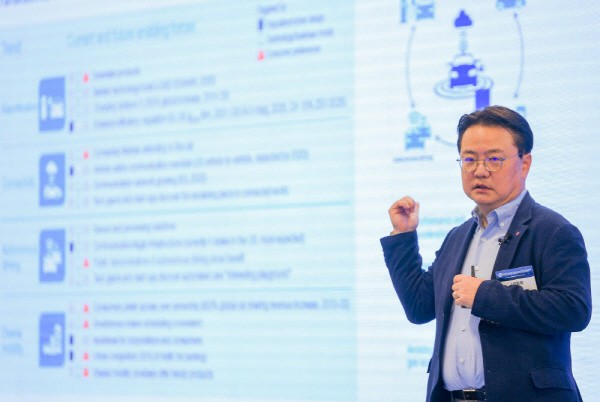LG and SK are actively expanding their battery business. In response to the growth of the electric vehicle market, it is targeting new markets not only for batteries but also in next-generation materials and battery recycling. K-battery industry's business is under the spotlight for how far its expansion will continue.

LG Chem will develop a 'cobalt-free' battery cathode material by 2025. Cathode materials that do not use cobalt are considered as next-generation materials to be used to electric vehicle batteries. This is the first time that LG has unveiled a plan to develop a cobalt-free cathode material.
At the keynote lecture on the 4th day (9th) of 'Global Tech Korea 2021’ held at COEX in Samseong-dong, Gangnam-gu, Young-min Choi, head of LG Chem's Battery Materials Center, said, "We are developing cathode materials for electric vehicle batteries that do not use cobalt completely. We are making thorough preparations to usher in the era of electrification of automobiles with automakers and battery makers.” LG Chem’s goal is to have cobalt-free battery by 2025 and development of cathode materials with 1 to 2% cobalt before that.
A cobalt-free cathode material is a material that has a potential to lower the price of batteries for electric vehicles. It can lower the manufacturing cost of batteries, which are core parts of electric vehicles, to less than $100 per kilowatt (kW). The best method for conventional cathode materials was to reduce cobalt to 5% or less among nickel (N), cobalt (C), and manganese (M).
However, the limit was reached by reducing cobalt below 5% and increasing nickel above 80%. The cathode material is a polycrystalline state that is agglomerated with various metal particles, and if the nickel content is increased and applied to the battery cell, the cathode material may be broken or crumbled. This is because the chemical structure is unstable when nickel is increased.
LG Chem demonstrates that cobalt-free cathode materials with nickel (N), manganese (M), and aluminum (A) compositions. No other company has developed NMA cathode materials as well as cobalt-free materials. Instead of cobalt, aluminum is used to keep the strength of cobalt while lowering the manufacturing cost. Aluminum has the lowest manufacturing cost among cathode materials.
Choi said, “We are concentrating on the development of cathode materials that do not contain cobalt, and we are also developing to increase the nickel content to 95% or more while gradually reducing cobalt. We are promoting the development of technology for the commercialization of cobalt-free with enhanced safety as a method of strengthening the coating.”
Choi added that it is also developing single-particle cathode materials in preparation for the all-solid-state battery era. The single-particle cathode material, which literally consists of a single particle of cathode material, is planned to be applied to all-solid-state batteries. In line with the commercialization of all-solid-state batteries, it will also promote technology development to complete the development of single-crystal cathode materials.
Choi said “LG Chem plans to have a diverse product portfolio in response to the demand for electric vehicle batteries. We will strengthen the development of cathode material technologies such as cobalt-free and improve cathode material development in line with the electric vehicle era.”
SK Innovation introduced the industry's first battery recycling business on the same day.
Tae-jin Kim, head of SK Innovation’s Environmental Research Center, said “SK Innovation is developing a technology to recover lithium hydroxide for the first time in the battery industry. In response to the difficult-to-treat waste battery market, we plan to recover lithium, nickel, cobalt, and manganese and recycle them as core materials for batteries”.
While battery material and recycling companies are starting to recycle waste batteries, SK Innovation plans to commercialize cathode materials. Manufacturing costs can be reduced while strengthening the supply chain of the main raw material for cathode materials.
At 'Global Tech Korea 2021', which began on the 6th, had a total of 29 keynote speakers; the semiconductor and materials, parts, equipment on the 7th, the display and materials, parts, and equipments on the 8th, and the battery and hot tech session on the 9th. Thematic presentation was conducted. A total of 3,000 viewers participated in this online conference for four days, and high-quality Q&A was conducted with the speakers.
By Staff Reporter Ji-woong Kim (jw0316@etnews.com)